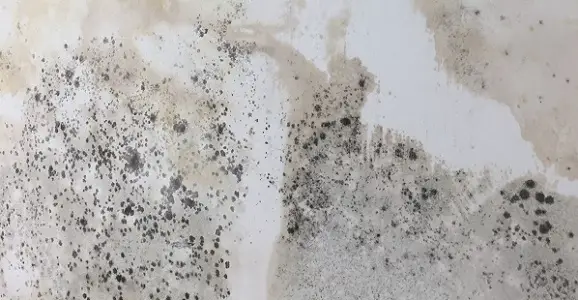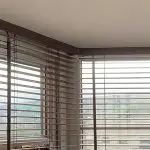The DIY Fix is reader supported. When you buy after clicking a link on our site, we may earn an affiliate commission.
Damp behind furniture is a common problem, but it’s causes and solutions aren’t always clear. Damp anywhere is a sign for concern, but particularly when it hides behind furniture. So how exactly does damp find its way behind your furniture?
The cause of damp behind your furniture is nearly always condensation. Water builds up in the air, this moisture-rich air will get trapped behind your furniture. Airflow isn’t exactly great down the back of your sofa, so the moisture builds up on cold surfaces and festers. Then it turns into damp.
Improving your airflow and wiping down condensation can prevent this.
Rising damp and penetrating damp are more worrying than condensation. But it is unlikely that either are the culprit here. If your damp is isolated behind furniture, then it is usually the fault of condensation. If you have rising damp, or penetrating damp it will usually be more wide spread, not just behind your bookcases.

Damp can have a serious effect on your health and that of your family, so having it behind furniture is a problem. Thankfully, fixing damp behind furniture isn’t all that complicated. Once you understand what causes condensation and how to stop it, things are pretty simple.
What Causes Condensation Damp?
The cause of condensation damp is moisture in the air building up on walls because of poor ventilation.
It is caused by moist air touching a cold surface, usually your walls. The condensation will linger and build up on the surface, where it causes damp. That moist air has a few different sources, but the outcome is always the same.
Water can find its way into your air from cooking or just general activities like sweating. In an ideal situation excess moisture will find its way out of your home. Sometimes though, it can’t escape. That is when it causes condensation and damp.
The moisture-filled air becomes trapped in your house. This trapped moisture will eventually settle on a cool surface inside your home. This is why damp builds up quickly in areas that have poor ventilation or a lot of water.
What are the Main Causes of Condensation?
The main causes of condensation that lead to damp are:
• Excess Moisture in the Air – This is where too much water builds up in your air. This can come from cooking, washing, drying clothes indoors, and even general activity. The average person sweats four cups of water into the air throughout the day.
• Heating – Warm air can hold more moisture than cold air. So, your temperature does affect condensation.
• Cold Surfaces – While hot air holds more moisture, cold surfaces will cause that air to become condensation. This makes moist or hot air a bad match for a cold wall.
• Ventilation – Air that has moisture built up needs to escape, if it can’t it will become condensation and then damp. Poor ventilation traps that moist air inside.
In the context of damp behind your furniture, these are all the causes of damp condensation. There are pretty simple ways to avoid this though.
11 Ways to Reduce Damp Behind Furniture
- Move Your Furniture Away from the Walls – Moving your furniture make a big impact on airflow.
- Avoid Big Changes in Temperature – Sudden changes in temperature will cause condensation to build up on surfaces rapidly. Try to heat or cool a room gradually.
- Regulate the Temperature in Damp Rooms – In rooms that are more prone to damp like kitchens and bathrooms, keep the temperature up.
- Open Windows – Even on a cold day, open the window up for 15 minutes to help your air circulate.
- Ventilation – Excess moisture from cooking can be treated with an extractor fan and air vents can help in a bathroom. This lets moist air out of the room.
- Shut Doors When Cooking or Bathing – Keep doors to kitchens and bathrooms closed for a few hours after use will stop that moist air from spreading.
- Wipe Things Down – Wipe down condensation as it forms before it becomes damp, especially windows and window frames.
- Allow Space for Air to Circulate – Allow some space for your air to circulate in a room with a condensation problem. This can be from moving furniture around or leaving more doors open.
- Ventilation Holes – If your damp is building up behind wardrobes or cabinets, ventilation holes make a big difference. Cut small holes in the back of cupboards and wardrobes to allow air to escape.
- Using a Dehumidifier – A dehumidifier is a very affordable way to remove moisture from the air in your property. It works by sucking in warm, moist air. Once the moist air is inside, it condenses. This means the moisture ends up inside the dehumidifier instead of on your walls. You can see an affordable dehumidifier with good reviews here on Amazon.
- Stay Vigilant – Damp from condensation is going to be a reoccurring problem in particular trouble spots. Keep on the lookout for signs of moisture building up, and make sure you’re doing what you can to cut down on damp.
Does the Position of my Furniture Matter? Can I Move My Furniture to Avoid Damp?
If damp is building up behind your furniture, it is usually at least somewhat because of its position, so moving it will often help.
External walls are much more prone to condensation. This is because moist air condenses when it hits a cool surface. External walls are colder, so they make an easier target.
The temperature of your wall makes a big difference. This is because of the way temperature interacts with moisture to create damp. A dew point is the temperature of a surface that acts as a threshold for humidity turning into condensation or dew.
Raising the temperature can prevent condensation, but exterior walls may still be quite cool. With a lower temperature, dew is still going to build up here.
Moving your furniture to interior walls can also help to stop the damp from building up. However, in some rooms, this isn’t going to be possible. However, moving your furniture just a few inches from a wall can make a big difference.
Mould on furniture but not on walls
In some instances, you may notice mould on your furniture as a result of damp. This is a common next step, and mould will often follow damp. Excess moisture and your furniture materials can make an ideal breeding ground for mould.
In some instances, you will find damp and mould on both your wall and your furniture. However, it is possible that the mould will be present on one, but not the other.
If there is no mould on the wall, but there is mould on the furniture, there are a couple of reasons this could be happening:
- The furniture material could be more absorbent and taking on more moisture.
- The wall is an internal wall that is warmer, and moisture is not drawn to it as a dew point.
This is quite common on soft furnishings like behind beds and on the back of sofas.
Whatever the reason, the cause of damp and mould is likely to be the same. That is high levels of humidity and moisture in the room and poor ventilation. Combine this with poor circulation behind the furniture, and mould is almost guaranteed.
To solve this issue, clean away any damp and mould from the area. Use a mould killing spray to completely eliminate mould spores. Following this, allow the area to dry. Once it is dry, aim to bring the furniture away from the wall slightly, this will improve circulation. Also, you should try to lower overall relative humidity in the room. This can be done in the same way we have mentioned earlier in this article.
Will Damp Proof Paint Stop Condensation?
Damp-proof paint does a good job of preventing damp from coming back, but it isn’t a full solution. Essentially, damp proof paint can help with condensation behind furniture. Although paint and addressing the causes of condensation works a lot better.
Anti-condensation damp paint primes your wall and acts as a type of insulation. It helps the surface regulate its temperature better, which helps to stop condensation from building up.
However, this is just paint and not magic! It will help prevent condensation from building up, but it isn’t a full solution on its own. Fixing your airflow and addressing the route causes of condensation are important, even with damp proof paint.
Conclusion
Damp behind furniture is built up by bad airflow and moisture trapped inside of your house. Things like the position of your furniture and exterior or interior walls have a big effect on how quickly this builds up. While it can be unsightly to have some damp behind lovely furniture, it’s a common problem.
Thankfully, there are pretty simple solutions. A few quick jobs to improve your airflow go a long way towards preventing damp from building up behind your furniture.




